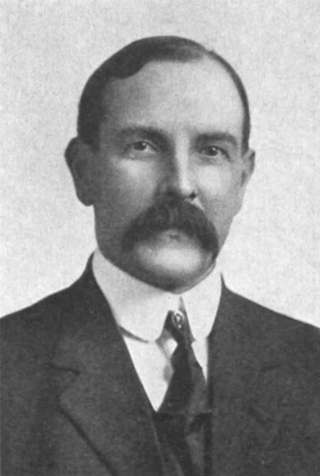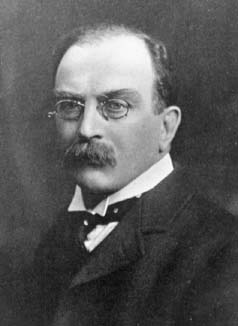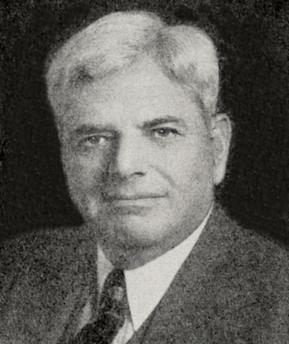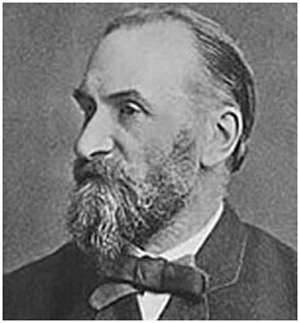Related Research Articles

Charles Proteus Steinmetz was an American mathematician and electrical engineer and professor at Union College. He fostered the development of alternating current that made possible the expansion of the electric power industry in the United States, formulating mathematical theories for engineers. He made ground-breaking discoveries in the understanding of hysteresis that enabled engineers to design better electromagnetic apparatus equipment, especially electric motors for use in industry.

Isadore Manuel Singer was an American mathematician. He was an Emeritus Institute Professor in the Department of Mathematics at the Massachusetts Institute of Technology and a Professor Emeritus of Mathematics at the University of California, Berkeley.

Arthur Edwin Kennelly was an American electrical engineer.

Sir Joseph Larmor was an Irish and British physicist and mathematician who made breakthroughs in the understanding of electricity, dynamics, thermodynamics, and the electron theory of matter. His most influential work was Aether and Matter, a theoretical physics book published in 1900.

Henry Augustus Rowland was an American physicist and Johns Hopkins educator. Between 1899 and 1901 he served as the first president of the American Physical Society. He is remembered for the high quality of the diffraction gratings he made and for the work he did with them on the solar spectrum.

Laurence Monroe Klauber, was an American herpetologist and the foremost authority on rattlesnakes. He was the first curator of reptiles and amphibians at the San Diego Natural History Museum and Consulting Curator of Reptiles for the San Diego Zoo. He was also a businessman, inventor, and contributed to mathematics in his study of the distribution of prime numbers.

John Roy Whinnery was an American electrical engineer and educator who worked in the fields of microwave theory and laser experimentation.

John James Stevenson was an American geologist, born in New York City. He graduated from New York University in 1863, became professor of chemistry at West Virginia University for two years (1869–71), then served as professor of geology at New York University until 1909. During 1873–74 and from 1878 to 1880 he was geologist for the United States Geological Survey. He also served on the Pennsylvania Geological Survey from 1875 to 1878 and from 1881 to 1882. He was president of the Geological Society of America in 1898.

James Gilbert Glimm is an American mathematician, former president of the American Mathematical Society, and distinguished professor at Stony Brook University. He has made many contributions in the areas of pure and applied mathematics.

Dugald Caleb Jackson was an American electrical engineer. He received the IEEE Edison Medal for "outstanding and inspiring leadership in engineering education and in the field of generation and distribution of electric power".
Richard James Duffin was an American physicist, known for his contributions to electrical transmission theory and to the development of geometric programming and other areas within operations research.

Albert Kingsbury was an American engineer, inventor and entrepreneur. He was responsible for over fifty patents obtained between the years 1902 to 1930. Kingsbury is most famous for his hydrodynamic thrust bearing which uses a thin film of oil to support weights of up to 220 tons. This bearing extended the service life of many types of machinery during the early 20th century. It was primarily outfitted on Navy ships during World War I and World War II.

William Grylls Adams was professor of Natural Philosophy at King's College, London. He was active in research on subjects ranging from light, magnetism, and astronomy to electrical power generation and transmission. His research in optics yielded the discovery that certain materials, notably selenium, produce an electric current when exposed to light. Adams also actively participated in many academic societies and held major positions within the societies.

William Patten (1861-1932) was an American biologist and zoologist at University of North Dakota and Dartmouth College noted for work on fossil ostracoderms, ideas on the origin of vertebrates from arachnids and his 1919 address to the American Association for the Advancement of Science and follow-up book about The Grand Strategy of Evolution: the Social Philosophy of a Biologist.

Michael Grain Crandall is an American mathematician, specializing in differential equations.

Roy Billinton is a Canadian scholar and a Distinguished Emeritus Professor at the University of Saskatchewan, Saskatoon, Saskatchewan, Canada. In 2008, Billinton won the IEEE Canada Electric Power Medal for his research and application of reliability concepts in electric power system. In 2007, Billinton was elected a Foreign Associate of the United States National Academy of Engineering for "contributions to teaching, research and application of reliability engineering in electric power generation, transmission, and distribution systems."
Robert Edward Ogren was an American zoologist.
Frank William Peek Jr. was an American electrical engineer and inventor, known as a pioneer in engineering research on the creation of extremely high voltage electricity. He is often given the sobriquet "inventor of man-made lightning". He is known for Peek's law.

Oscar Terry Crosby was an American engineer, executive, author, and explorer. A West Point graduate, he served as the United States Assistant Secretary of the Treasury during World War 1.
References
- 1 2 3 4 5 "Dr. Louis Bell", Nature, 112 (2805): 172, 1923, Bibcode:1923Natur.112Q.172., doi: 10.1038/112172a0 , S2CID 26164307.
- 1 2 3 4 5 6 7 8 9 10 Kennelly, A. E. (January 1925), "Louis Bell (1864-1923)", Proceedings of the American Academy of Arts and Sciences, 59 (17): 633–639, JSTOR 20026116.
- 1 2 3 Motter, H. L., ed. (1911), "Bell, Louis", Who's Who in the World, International Who's Who Publishing Company, p. 109.
- ↑ Pyenson, Lewis (2020), The Shock of Recognition: Motifs of Modern Art and Science, Nuncius Series, vol. 5, BRILL, pp. 305–306, ISBN 9789004325739.
- ↑ Holmes, Rick (February 11, 2016), "Bell family left its mark on New Hampshire, nation", Derry News, retrieved 2023-01-12.
- ↑ Louis Bell Papers, 1828-1900, University of New Hampshire, 6 January 2021, retrieved 2023-01-12.
- ↑ Bell, Mary Ann (1834-1865), New Hampshire Historical Society, retrieved 2023-01-12.
- 1 2 3 4 Capace, Nancy (2001), "Bell, Louis", in Motter, H. L. (ed.), The Encyclopedia of New Hampshire, Somerset Publishers, Incorporated, pp. 168–170, ISBN 9780403096015.
- ↑ Chase, John Carroll (1926), History of Chester, New Hampshire, Including Auburn: A Supplement to the History of Old Chester, Published in 1869, Derby, New Hampshire, p. 159.
{{citation}}: CS1 maint: location missing publisher (link) - 1 2 3 "Louis Bell", Dartmouth 1884: A History, pp. 68–69, 1909.
- ↑ Allerhand, Adam (January 2020), "The Earliest Years of Three-Phase Power—1891–1893", Proceedings of the IEEE, 108 (1): 215–227, doi:10.1109/JPROC.2019.2955618, S2CID 210078514 , retrieved 2023-01-13.
- ↑ The Birthplace of the AC Grid, Prometheus Institute, September 10, 2021, retrieved 2023-01-13.
- ↑ Houston, James P. (January 1929), "Class of 1884", Dartmouth Alumni Association, retrieved 2023-01-13.
- ↑ DiLaura, David (27 July 2016), History, Illuminating Engineering Society, retrieved 2023-01-13.
- ↑ King, Edward S. (December 1923), "Louis Bell", Popular Astronomy, 31 (10): 635–640, Bibcode:1923PA.....31..635K.